Imagine craggy coastlines that meet emerald forests, where the scent of pine is carried by the salty sea breeze. Picture a spot where sunrises ignite the sky in fiery oranges and vibrant pinks, casting a magical glow over the landscape. Adventure waits around every corner, whether it’s hiking along rugged trails that offer breathtaking views or kayaking through tranquil waters teeming with wildlife. Welcome to Acadia National Park, a true gem of the East Coast. It’s a sanctuary of natural beauty along Maine’s shores, inviting visitors to bask in the serene embrace of nature while creating memories that last a lifetime.
Acadia has hiking trails, historic carriage roads, stunning ocean views, and lots of wildlife. Ready to explore?
This guide provides everything to plan your trip to Acadia. Learn about the best times to visit. Discover must-see spots. Get insider tips for a great experience.
Table of Contents
Planning Your Visit to Acadia National Park
Planning your visit to Acadia National Park is very important. Without good planning, your trip might not go smoothly. It helps you make the most of your time and avoid problems. First, think about the best time to go. The park is busy in summer, from June to August, when most visitors come. If you want fewer crowds and cooler weather, consider visiting in late spring or early fall. Fall, from September to October, offers amazing fall colors and less busy trails. Winter visits are quieter but some roads and parts of the park may be closed. Checking the weather forecast before you plan helps you pack the right clothes and gear. Snow and cold temperatures can appear suddenly in winter.Next, decide how you will get there. The park is near Bar Harbor, Maine. Many visitors drive their own cars, which makes traveling around easier. You can also rent a car if you don’t have one. Some travelers arrive by plane, landing at Bangor International Airport, about an hour and a half away. From there, you can rent a car or take a shuttle service. Public transportation options are limited, so having a car is a big help. If you are coming from far away, you might plan to fly into Portland, Maine, then drive or take a bus to the park. Think about how long the trip will take, and plan your driving route in advance. You can find detailed maps on the park’s website to help you.Knowing where to stay is also very important. The park offers campgrounds, hotels, and rental homes. The campground at Blackwoods and Seawall is popular for campers. If you prefer hotels, nearby towns like Bar Harbor have many choices, from small inns to big resorts. Booking your accommodations early is recommended, especially during the busy summer months. You might also look for vacation rentals or cabins if you want more space. Decide what type of lodging fits your budget and plans. Remember, staying inside or near the park makes it easier to explore early in the morning or stay late.Finally, consider costs. Visiting Acadia can vary in price based on your plans. Entrance fees are around $30 per vehicle for a week. If you plan to do lots of activities, pay attention to costs for boat tours, guided hikes, or bike rentals. Food expenses can add up, so packing snacks or meals might save money. Gas prices can affect your budget if you’re driving. Plan ahead by making a list of expenses and setting a budget. This way, you avoid surprises and enjoy your trip without financial stress.Good planning covers all these basics and helps turn a simple visit into a memorable adventure. Taking the time to prepare makes it easier to enjoy every moment in this beautiful park.
Best Time to Visit Acadia National Park
The best time to visit Acadia National Park depends a lot on the season. Each part of the year offers a different experience. Summer, from June to August, is the most popular time. The weather is warm, making it great for outdoor activities like hiking and biking. Many visitors come during these months to enjoy the park’s beauty. Popular spots such as Cadillac Mountain fill up fast. Expect large crowds at popular trails and viewpoints. Prices for accommodations and tours also go higher during summer. It’s a lively and busy season that draws tourists from all over.
Spring and fall are quieter times for the park. From April to May and September to October, the weather is usually pleasant. It’s a good time for those who want to enjoy nature without the big crowds. Spring brings blooming flowers and fresh greenery, while fall displays stunning colors. The trees turn bright shades of orange, red, and yellow, creating a picture-perfect landscape. Many visitors find these seasons ideal for peaceful walks and scenic photography. Fewer people visit, so it’s easier to find a quiet spot and enjoy the natural beauty.
Winter presents a very different view of Acadia. From November to March, the park is cold and often snowy. This is a time when the landscape becomes quiet and still. Many roads and trails close because of snow and ice, making driving and hiking harder. But this season also brings a sense of peace. Some travelers come seeking solitude and a chance to see the park in a more wild state. Cross-country skiing and snowshoeing are popular ways to explore the snow-covered land. The quiet winter months let visitors experience the park’s beauty away from the crowds.
Each season has its own charm. Summer is lively and vibrant. Spring and fall offer peaceful moments and beautiful scenery. Winter is quiet and full of calm. Visitors should choose the best time for what they want to see and do. No matter the season, Acadia offers unique sights and experiences for every traveler.
Getting to Acadia National Park: Transportation Options
Getting to Acadia National Park is not as hard as many believe. There are several easy ways to reach this beautiful place. You can drive, fly, or take public transportation. Each option has its own benefits and drawbacks, so choose what fits best with your plans and budget.
Driving is the most common way for visitors. Roads are well maintained, and traveling by car gives you freedom to move at your own pace. Many visitors drive from nearby states or from cities farther away. You can take Route 1 along the coast, which offers scenic views of the Atlantic. Others prefer to use I-95, which takes you through Maine’s interior and connects to shorter routes to the park. Once you get close, signs will direct you to Bar Harbor and Acadia. Having a car makes it easier to visit different parts of the park at your own pace, especially if you want to explore multiple sites or enjoy a picnic along the way.
Flying is another good choice, especially if you are coming from far away. The closest airport is Bangor International Airport, known as Bangor BGR. It is about an hour’s drive from the park. Once you land, you can rent a car easily from the rental booths at the airport. This allows you to drive directly to the park and stay flexible with your schedule. Many airlines fly to Bangor from major cities, making it a convenient gateway for visitors.
Public transportation is a third option, especially for those who want to avoid driving or want to save money. Bus lines connect Bangor and Bar Harbor to nearby towns and cities. These buses are reliable and offer an easy way to get to the park. During peak season, which runs from late spring to fall, the “Island Explorer” shuttle operates free of charge. This special bus runs between many popular spots inside Acadia, including Sand Beach, Jordan Pond, and Cadillac Mountain. It helps visitors avoid the hassle of finding parking, which can be difficult during busy summer months. Using the shuttle is a smart choice for those visiting during the summer rush, as it reduces travel stress and helps protect the park’s natural beauty by cutting down on cars and traffic.
While driving is simple and flexible, it’s important to prepare for parking issues. During summer, parking spots near popular areas fill up fast. Using public transport and the free shuttle makes your trip smoother and more enjoyable. Whether you drive, fly, or take the bus, each option gets you closer to experiencing everything Acadia has to offer.
Accommodation: Where to Stay In and Around Acadia National Park
Accommodation options in and around Acadia National Park are plentiful. Visitors can choose to stay inside the park itself or opt for nearby towns just outside the boundaries. Inside the park, camping is a popular choice. Blackwoods Campground and Seawall Campground are two of the most well-known spots. They offer a true outdoor experience, letting visitors sleep under the stars surrounded by nature. It’s best to reserve spots early, especially in summer months, as these campgrounds fill quickly. Many travelers plan their trips months in advance to secure a spot, as there are a limited number of sites.
For those who prefer more comforts, there are many hotels and inns close to the park. The town of Bar Harbor is especially popular. It has a wide range of accommodations, from upscale hotels to cozy inns and vacation home rentals. Bar Harbor is located just minutes from the Park’s entrance, making it easy to explore the area. Visitors can find options like the Harborside Hotel or the Inn on Mount Desert, which offer easy access and plenty of amenities. Staying in Bar Harbor also means having easy access to restaurants, shops, and sightseeing spots after a day in the park.
Another nearby town worth considering is Southwest Harbor. It has a calmer, quieter vibe compared to Bar Harbor. Visitors here can enjoy a more peaceful stay in local inns, bed-and-breakfasts, and rental homes. This area suits those looking for a relaxed atmosphere with fewer crowds. Camping in Southwest Harbor is also budget-friendly, with several nearby campgrounds and open spaces. Hotels and lodges in this area tend to be more affordable, and they often provide more space and privacy.
Choosing where to stay depends on what each visitor wants. Those who love camping and outdoor activities often prefer the park’s campgrounds for a real adventure. Travelers seeking comfort and convenience might pick a hotel or rental in Bar Harbor. Budget-conscious visitors can find cozy inns or campgrounds that fit their budget. Rentals can provide plenty of space for families or groups, making them a good option for those traveling with friends or large families. Whether camping, staying in a hotel, or renting a home, there are options to suit every style and budget.
Overall, planning ahead is essential. Accommodations inside the park, especially campgrounds, often fill up early in busy seasons like summer. For the best experience, make reservations months ahead. Outside the park, many towns offer flexible options that can be booked closer to your travel dates. No matter what you choose, staying close to Acadia helps visitors make the most of their trip and explore the area comfortably.
Must-See Attractions and Activities in Acadia National Park
Acadia National Park is filled with well-known landmarks that attract visitors from all over. You can see stunning mountain views from Cadillac Mountain, the highest point on the East Coast. The park also has beautiful lakes like Eagle Lake and Jordan Pond, which are perfect spots for short walks or boat rides. Many visitors come to see the rugged cliffs at Thunder Hole, where waves crash and spray the air with mist. These sights are what make Acadia a special place for nature lovers and travelers alike.
The park offers many scenic drives that let you enjoy the landscape without leaving your car. Park Loop Road is the most popular, winding through forests, mountains, and coastline. It gives visitors quick access to key spots like Sand Beach and Otter Cliffs. You can also take the Cadillac Summit Road for a drive to the top of Cadillac Mountain, where you get a sweeping view of the islands and ocean below. These drives are a great way to see a lot of the park’s beauty in a short time, especially if you plan to visit multiple attractions.
Acadia also offers a wide range of outdoor activities. Visitors can enjoy hiking on over 50 miles of trails, with routes for all skill levels. Biking is popular on the Carriage Roads, which are smooth, mostly car-free paths perfect for families and casual riders. During the summer, many people kayak in the nearby waters or go swimming at beaches like Sand Beach. Fishing, bird watching, and picnicking are also common ways to spend time outdoors in the park. In winter, certain trails are open for snowshoeing and cross-country skiing. The variety of outdoor options makes it easy for everyone to find something they enjoy.
Visitors who want to see and do it all should plan ahead. With so many natural sights and opportunities for fun, it’s best to reserve enough time. Exploring the iconic sights like the mountain tops, shoreline, and scenic roads can fill a few days. Each activity and landmark adds something special to the experience. Make sure to include both the famous spots and some of the lesser-known paths to fully enjoy what Acadia has to offer. Don’t rush, and leave enough time to truly enjoy each moment in this beautiful park.
Cadillac Mountain: Sunrise Spectacle and Panoramic Views
Cadillac Mountain stands at the top of Mount Desert Island in Maine. It has the highest elevation on the U.S. Atlantic coast, standing at about 1,530 feet. Because of its height, it offers visitors stunning views of the surrounding area. Watching the sunrise here is a truly memorable experience. Many people say that the first light of dawn seen from Cadillac Mountain is unlike any other. During certain times of the year, it is the very first place in the entire country to see the sunrise. This happens because the mountain’s position allows it to catch the first rays of morning sunlight before other parts of the U.S. wake up.
You can drive to the top of Cadillac Mountain, which makes it easy for most visitors to get there. In recent years, parking at the summit has become more challenging, so reservations are now required for those who want to see the sunrise. This helps prevent crowds and ensures everyone has a good spot to enjoy the view. Once at the top, visitors are treated to breathtaking scenes. You can look out and see the islands of Frenchman Bay, the lush green forests, and the vast Atlantic Ocean. The scenery changes with the weather and time of day, making each visit unique.
Many travelers come just for the sunrise, eager to see the spectacular colors fill the sky. But the views from Cadillac Mountain are impressive at any time. During daylight hours, you can see miles of rocky coastline and little islands dotting the ocean. Sunsets here are equally beautiful, casting a warm glow over the scene below. Even on cloudy days, the mountain offers fantastic scenery. It’s a perfect spot for photography or simply enjoying the peace of nature.
This mountain has been a popular place for visitors for many years. Its distinct location makes it a symbol of Maine’s natural beauty. People come from all over the world just to stand at the summit and take in the incredible landscape. Whether you visit to see the sunrise or to relax and enjoy the views throughout the day, Cadillac Mountain never fails to impress.
Park Loop Road: A Scenic Journey Through Acadia’s Heart
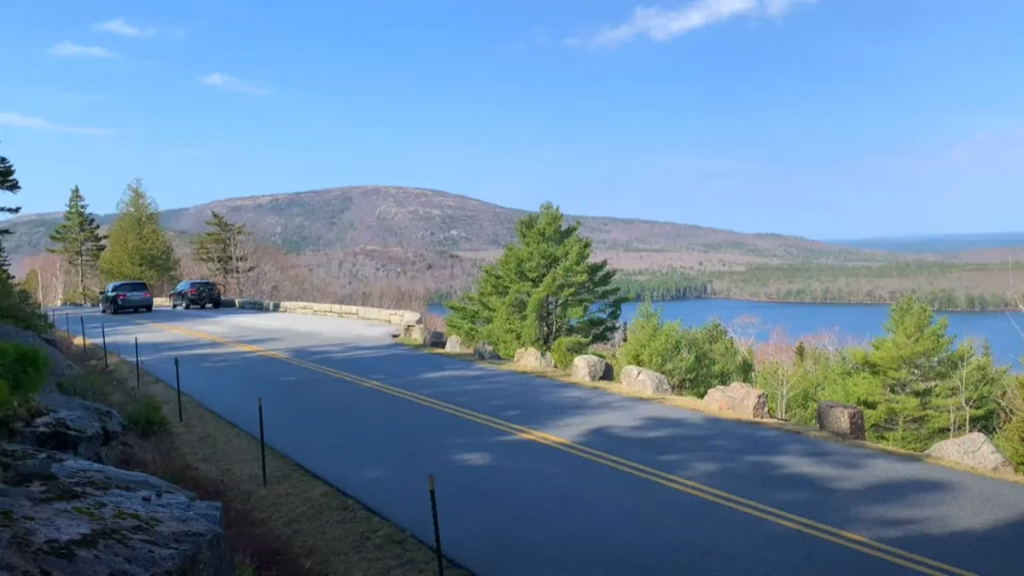
Park Loop Road is a beautiful and winding drive that takes visitors through the heart of Acadia National Park. It covers about 27 miles of scenic views and natural beauty. The road loops around the coast and through dense woods, offering many chances to see stunning sights. As you drive, you’ll come across famous spots like Sand Beach, where soft white sand meets the chilly Atlantic Ocean. You can often see people relaxing or swimming there in the summer. Thunder Hole is another popular stop, where giant waves crash into a rocky inlet and make loud booming sounds. Otter Cliffs offer breathtaking views of the ocean from high up on the rocks and are perfect for taking photos. The drive itself is smooth and easy, with gentle curves that make the journey relaxing. You don’t have to worry about difficult driving conditions. Still, finding a parking spot at the popular sites can be hard, especially during busy months. Parking lots often fill up quickly, so arriving early in the morning or late in the afternoon helps you avoid large crowds. The beauty of these spots makes the effort worth it. The views of the coast, the rugged cliffs, and the waves crashing below create memorable moments. Many visitors find that this drive offers an experience they won’t forget. As you pass each site, take your time to enjoy the scenery, breathe in the fresh air, and listen to the sounds of nature. The drive is a chance to see some of the most scenic parts of Acadia and to understand why people come back year after year.
Hiking Trails: Exploring Acadia National Park on Foot
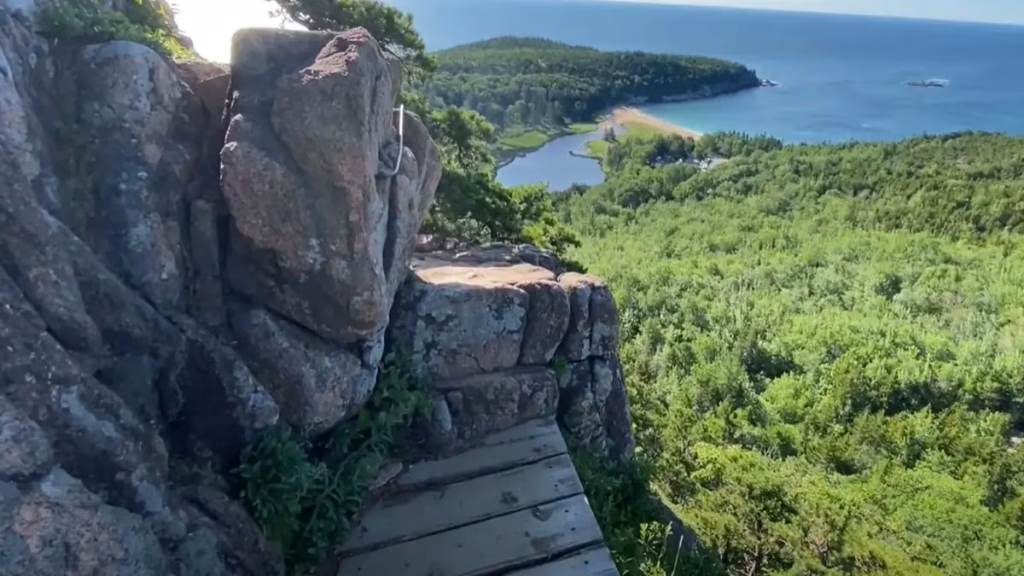
Acadia National Park offers a wide range of trails suitable for every type of hiker. Whether you want a quick walk or a tough climb, there’s something here for you. One of the most popular trails is the Beehive Trail. It is famous because of its steep sections that use iron rungs and ladders to help you rise up the mountain face. This trail is about 1.5 miles long and features a loop that provides stunning views of the park and the nearby Atlantic Ocean. Being quite challenging, this trail attracts many visitors who are looking for an exciting hike with rewarding scenery. However, it is not suited for small children or anyone who has a fear of heights. Dogs are not allowed on this trail to keep the path safe for everyone. A good tip is to start your hike early in the day because the trailhead is near Sand Beach. Parking fills up quickly later in the day, especially during busy seasons. The trail itself includes rock scrambles and iron ladders, which require some strength and surefootedness. The climb to the summit offers breathtaking views of the rugged coast, the lush forests, and the distant islands. It’s a trail where you will feel a real sense of adventure and accomplishment.
Another challenging trail is the Precipice Trail. This route is best for experienced hikers because of its steep and exposed sections. Imagine climbing up iron rungs, hundreds of feet above the ground, with the salty sea breeze blowing past you. That’s what the Precipice Trail offers. It’s located on Mount Cape, one of the tallest peaks in the park. The trail is very narrow and features many points where you need to use your hands to scramble over rocks and climb ladders. It’s a true test of balance, strength, and courage. Only those who are comfortable with heights and have good outdoor skills should try this trail. The reward is spectacular views of the Atlantic Ocean, the rocky cliffs below, and the wooded valleys around. Because of the danger, the trail is closed during certain weather conditions like rain or high winds. It is wise to check the weather forecast before starting your hike. Remember, safety comes first with this trail. It’s a perfect choice for thrill-seekers looking for a memorable outdoor challenge.
For a more relaxed walk, the Jordan Pond Path is ideal. This trail offers a calm way to enjoy the beauty of Acadia. It’s a flat, gravel path that circles around Jordan Pond, a peaceful body of water nestled in the mountains. The whole loop covers just over 3 miles, making it easy for most people to walk at any pace. Along the way, you’ll see great views of the Bubbles, two distinctive mountain peaks that rise on opposite sides of the pond. The trail is well-maintained and accessible from the Jordan Pond House, a historic spot where visitors can enjoy tea and famous popovers. It’s perfect for families, seniors, or anyone who wants a slow and scenic walk. Listening to the gentle ripples of the pond and looking out at the distant mountains creates a peaceful experience. It’s also a good trail if you want to take photos or just relax in nature. Since it’s so easy to access, many people use this trail as a starting point before exploring other parts of the park. The Jordan Pond Path gives a chance to enjoy Acadia’s beauty without much effort but with plenty of chances to connect with nature.
Overall, these trails show the diversity of Acadia National Park. From the steep and daring Beehive to the vertical challenge of the Precipice, and the easy, scenic walk around Jordan Pond, there’s a trail for everyone. Each offers a unique way to see the park’s stunning landscapes and experience Maine’s rugged beauty. Whether you’re looking for adventure or relaxation, hiking in Acadia will give you a lasting memory of this special place.
Exploring Acadia’s Natural Wonders
Acadia’s nature is special. It has unique geology. Diverse ecosystems thrive. Wildlife is abundant.
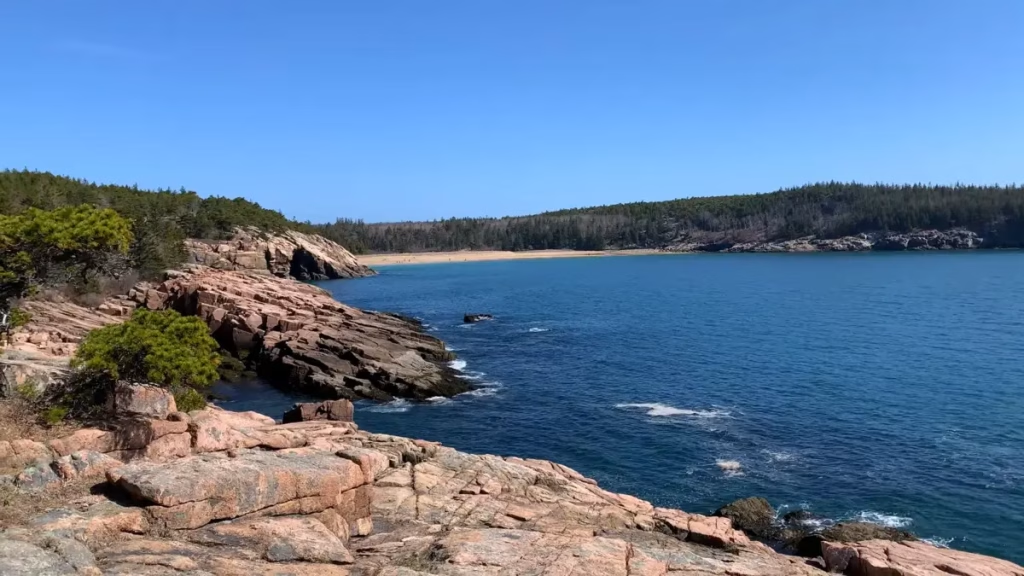
The Granite Coastline: Acadia’s Rugged Beauty
Acadia’s coastline is rough and jagged. It has steep cliffs that drop into the sea and sandy beaches that stretch out gently. You can find small tide pools hiding among the rocks, filled with clear water when the tide goes out. The land here was shaped by huge glaciers during the last ice age. These glaciers carved the stone and left behind the rugged cliffs and smooth, rounded rocks visible today.
Because of powerful winds, rain, and waves, the coastline is always changing. Rocks crack and fall, beaches grow or shrink, and tide pools look different each day. Erosion slowly wears down the cliffs, sending pieces tumbling into the ocean below. Weathering, or the breaking down of rocks over time, also plays a big role. The combination of these natural forces keeps transforming the coast in ways that are sometimes gentle and other times dramatic.
Exploring tide pools is like discovering a small world in itself. When you visit these tiny water habitats, look carefully. You might see crabs scuttling across the rocks, starfish clinging to the sides of pools, or snails slowly crawling along the surfaces. The ocean’s waves constantly crash against the rocks, showing how strong and powerful the sea can be. This raw energy shapes the land and creates a rich environment for many small ocean creatures.
The coastline’s constant change shows nature’s strength. The waves keep hitting the rocks, slowly shaping the cliffs and beaches you see today. Every visit might reveal something new, as erosion and weathering continue to work. This ever-changing scene reminds us how powerful the ocean and weather are, constantly reshaping the land in ways that are both beautiful and wild.
Diverse Ecosystems: Forests, Lakes, and Wetlands
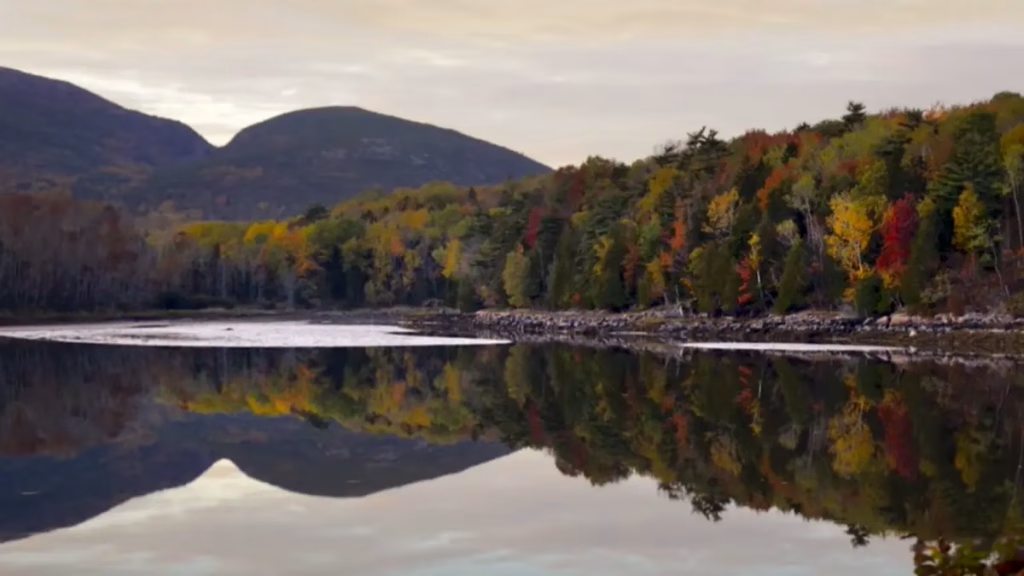
Acadia National Park is home to many different types of habitats. Visitors can find forests, lakes, and marshes all packed with a variety of plants and animals. Each habitat provides a special home for different kinds of wildlife and offers unique views. When exploring the park, you might notice that the forests are mostly made up of coniferous trees. These trees, like pine and spruce, stay green all year and give the forest a dark, lush look. These forests cover much of the park and are important for many animals like deer, foxes, and many species of birds.
The lakes in Acadia offer calm, quiet spots for visitors to enjoy. Freshwater lakes, like Eagle Lake and Jordan Pond, are perfect places for pictures and relaxing. These lakes are clear and still, making them good spots for fishing and boating. They also attract animals such as loons, ducks, and beavers. The peaceful waters seem to mirror the sky, giving visitors a sense of calm and beauty.
Saltwater marshes are another special part of the park’s habitat. These wetlands are full of life and energy. They are shallow areas where fresh and saltwater mix, creating a rich environment for plants and animals. Marshes are busy places with insects buzzing, and birds like herons and swans hunting for food. Many small creatures, such as frogs and snails, call these marshes home. People often see many different kinds of birds flying above or wading through the water. The marshes play a key role in keeping the ecosystem healthy and balanced.
Seeing all these habitats helps visitors understand how different plants and animals depend on each other. The forests, lakes, and marshes make Acadia special. Each one offers a new way to experience nature and teaches us the importance of protecting these places. From towering trees to calm lakes and lively marshes, these habitats show how diverse and full of life Acadia truly is.
Wildlife Encounters: Observing Acadia’s Residents
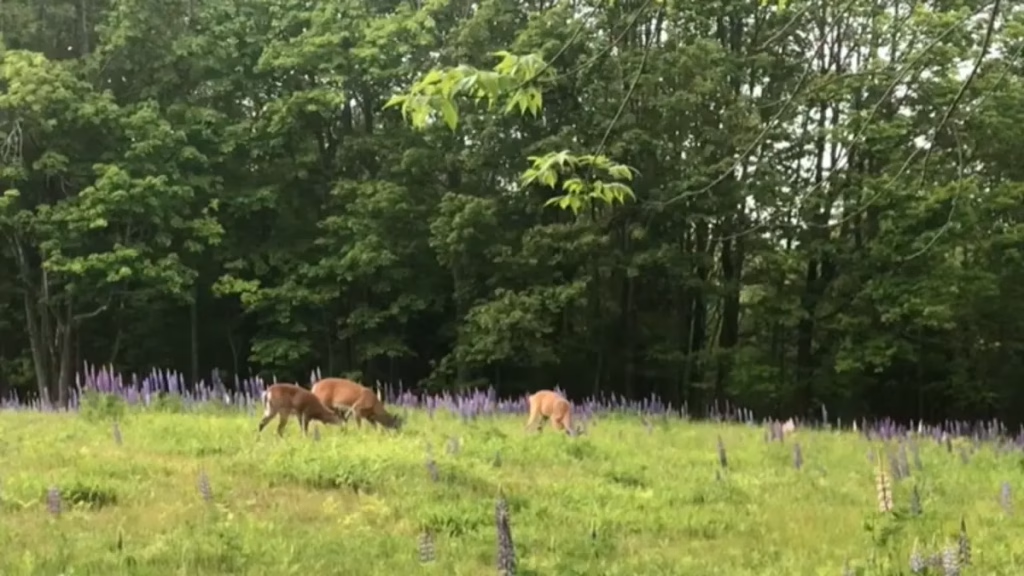
Acadia National Park is a place where many different animals live. Visitors can see a variety of wildlife in their natural homes. You might spot colorful birds flying overhead or perched on tree branches. Some common birds include jaegers, chickadees, and warblers. Seals are another popular sight. Often, they rest on rocks near the shore, soaking up the sun. Watching seals sunbathe is a favorite activity for many visitors. They seem relaxed as they lounge on the rocks, sometimes barking to each other.
Deer also roam the meadows and forest areas of the park. They spend their days grazing on grass and shrubs. Their gentle movements make them a common sight in many parts of Acadia. Porcupines can be found wandering through trees or crawling over logs at night. They are shy animals and become nervous if approached.
It is very important to be respectful to all the animals in the park. They are in their natural environment and do not like being disturbed. Keep a safe distance whenever you see wildlife. Do not try to pet or feed any animal. Feeding animals can make them lose their natural fear of humans. This can be dangerous for both animals and visitors.
Enjoy watching and taking photos of these animals from afar. Watching them behave normally in their habitat gives you a real sense of their world. Remember, the best way to help protect wildlife is to observe quietly and stay out of their space. When you keep your distance, you help keep the animals safe and healthy. This is how visitors can make a positive impact and preserve the beauty of Acadia’s wildlife for future generations.
Tips for an Unforgettable Acadia Experience
Maximizing your trip to Acadia National Park means planning ahead. Think about your safety first. The park has many beautiful trails, but some can be slippery, especially after rain or snow. Pay attention to trail conditions, and walk carefully. Weather in the park can change quickly. A clear morning can turn into a stormy afternoon, so be prepared. Wildlife is also unpredictable; always keep your distance and do not feed animals. Remember, your safety depends on staying alert and prepared for surprises at any time.
Make sure to wear good, comfortable shoes that can handle uneven ground. Hiking boots with good grip are best. Dress in layers that you can add or remove as the weather shifts. For example, a light T-shirt topped with a waterproof jacket works well. Bring plenty of water to stay hydrated during hikes, and pack some snacks for energy. It’s always smart to let someone know your plans. Share your route and expected return time so help can find you if needed. Carry a small first aid kit for minor cuts or scrapes. Being ready for any situation will make your visit safer and more enjoyable.
Packing for Acadia means being smart about what to bring. Layers are very important because the weather can be cold in the morning and warm by noon. Good hiking boots are a must to support your feet on rocky paths. Rain gear is essential, even if the forecast shows clear skies. A lightweight raincoat or waterproof jacket can keep you dry. Sunscreen protects your skin from sunburn, especially at higher elevations. Insect repellent helps keep away pesky bugs during the warmer months. A reusable water bottle helps you stay hydrated and reduces waste. Don’t pack too much, but enough to handle sudden weather changes. Being prepared will ensure you don’t get caught in rain or sun without the right gear. This simple packing list helps you enjoy Acadia fully and safely, no matter what the weather does.
Beating the Crowds: Strategies for a More Peaceful Visit
Acadia National Park can get very busy, especially during the peak season. Many visitors flock to popular spots like Cadillac Mountain and Jordan Pond, making parking difficult and trails crowded. To avoid this, plan your visit early in the morning or later in the afternoon. The best times are before 9 AM or after 4 PM, when crowds thin out. During these times, you can enjoy the quiet beauty of the park and have a more peaceful experience.
Exploring less-known trails can help you avoid crowds as well. Trails like the Wonderland Trail, which is a bit hidden, offer a quieter way to see the park. These less crowded paths are often just as stunning and give you a chance to enjoy nature without the busy scenes found on main roads and popular spots. It’s a great way to experience the park’s beauty in a calmer setting.
The Island Explorer bus system is a valuable tool for visitors. The shuttle is free and runs throughout the park during the busy months. It stops at many key locations, including the main trailheads, visitor centers, and beaches. Using the shuttle can save you from the hassle of finding parking, which can fill up quickly in busy times. It is especially helpful if you want to visit popular spots but don’t want to spend time waiting for a parking spot or walking long distances. The shuttle makes it easy to move around the park and spend less time worrying about where to park and more time enjoying the scenery.
Conclusion
Acadia National Park is truly an amazing place. It has so much to offer every visitor. Whether you enjoy outdoor activities or just want to enjoy stunning natural beauty, this park has something for everyone. When planning your trip, take the time to explore all its many features. Discover Maine’s hidden gem and see why so many people fall in love with this special place.
Remember to explore the many hiking trails that wind through the mountains and along the coast. These trails offer breathtaking views and a chance to immerse yourself in nature. Some popular hikes include Jordan Pond Path and Beehive Trail, which challenge and reward hikers with stunning scenery. Don’t forget to take scenic drives around the park, such as the Park Loop Road, which provides spectacular views of the ocean, mountains, and forests in one easy trip. These drives are perfect for catching sights you might miss on foot.
Enjoy the wildlife in the park. Keep an eye out for deer, moose, and many bird species. You might see seals swimming off the shore or ospreys soaring overhead. The park’s diverse habitats make it a perfect place to observe animals in their natural environment. Respect the animals and remember to keep a safe distance so everyone can enjoy watching them.
While having fun is important, safety should always come first. Make sure you stay prepared when exploring. Wear good shoes, bring plenty of water, and watch the weather. If you’re hiking, tell someone your plans and stick to marked trails. Being cautious helps prevent accidents and ensures everyone can enjoy their trip safely.
Visiting Acadia is more than just checking off an item on your bucket list. It’s about connecting with nature in a real way. The peaceful forests, rugged coastline, and quiet lakes create a perfect setting to relax and find calm. If you want to challenge yourself, try more difficult hikes or kayak along the coast. Pushing your limits can be rewarding and boost your confidence. Every visit creates chances to make memories that last a lifetime.
Take some time to plan your visit. Find out the best times to go, usually from late spring to early fall, when the weather is nicest. Consider staying overnight so you can get the most out of your trip. Whether you spend a night in a cozy cabin or camp under the stars, you will wake up ready to explore more.
Discover the magic of Maine’s coast. The piece of land where the mountains meet the Atlantic Ocean is full of natural beauty and surprises. From peaceful beaches to towering cliffs, each part of Acadia tells a different story. Use your trip as a chance to learn, explore, and relax. It is a place that inspires everyone who visits.
In short, Acadia National Park is not just a destination. It is a place to find peace, adventure, and new experiences. It’s a place to see the beauty of nature up close. Challenge yourself with new hikes or drives, enjoy watching wildlife, and take in the stunning views. Everyone can find something to love here. Plan your trip now, and see why so many people choose Acadia for their great outdoor escape. Explore the beauty and quiet magic of Maine’s coast today.

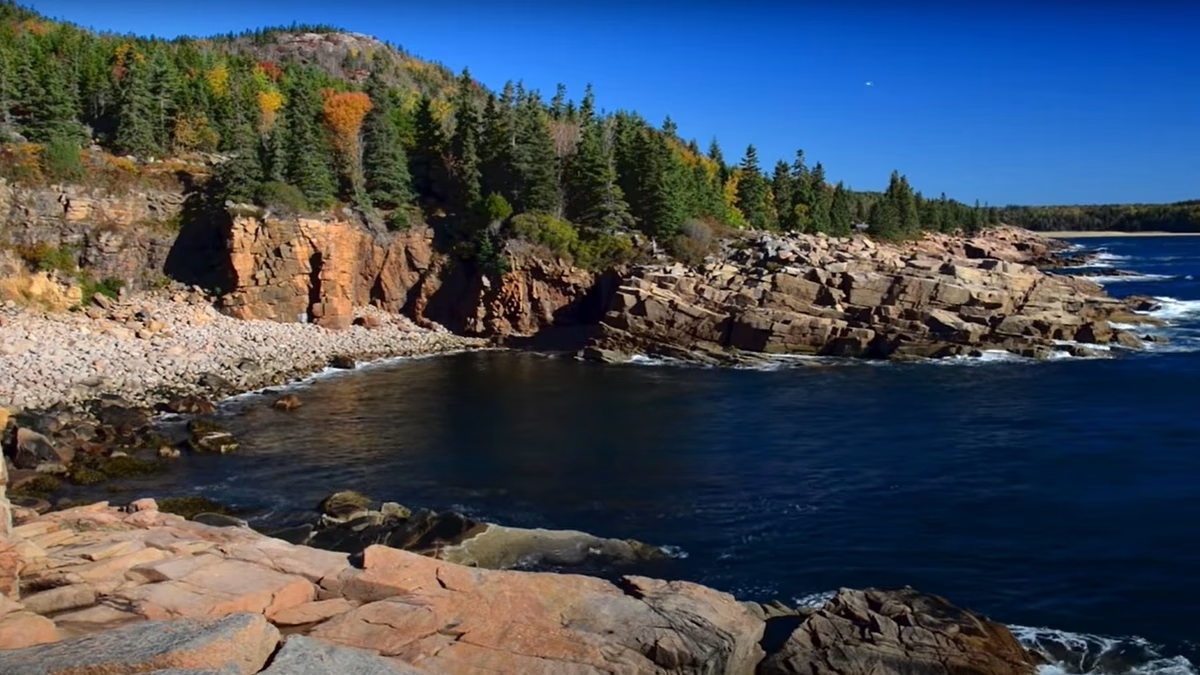
Leave a Reply
You must be logged in to post a comment.